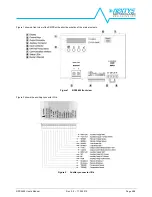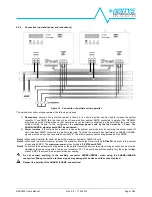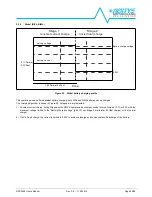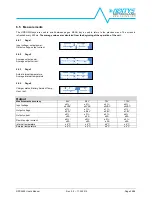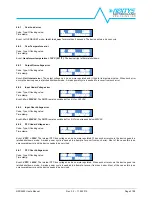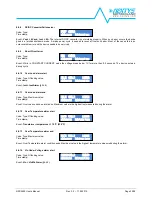
NPS2400
User’s Manual
Rev. 3.0
– 17.02.2015
Page 19/38
5.3
Battery charger mode (available only on “-24” and “-48” models)
5.3.1
Lead acid
C
u
rr
e
n
t
(A
)
C
e
ll
v
o
lt
a
g
e
(
V
)
Time (hrs)
3
6
9
12
0.04C
0.08C
0.12C
0.16C
0.20C
0.5
1.0
1.5
2.0
2.5
Charge current
Cell voltage
Stage 1
constant current charge
Stage 2
constant voltage charge floating charge
Stage 3
Figure 19 Lead acid battery charging profile
This operating mode performs
lead-acid
battery charging. 12V, 24V or 48V batteries from 50Ah to 1000Ah can be charged. 2
charging modes are possible:
normal charge
and
fast charge
.
In normal charge mode the charge current is limited to 0.1C (C = battery nominal capacity expressed in Ah) and the charging
time takes approximately 12h. In fast charge mode the charge current is limited to 0.2C and the charging time is approximately
8h.
The charging algorithm is shown in Figure 19, 3 stages are implemented:
1)
Constant current charge
: during this phase the SMPS operates as a constant current source limited at 0.1C or 0.2C. The
battery voltage progressively increases until it reaches the constant voltage charge value. Stage 2 starts when this voltage is
reached.
2)
Constant voltage charge
: during this phase the SMPS operates as a constant voltage source limited in current at 0.1C or
0.2C. The output voltage is kept constant at 14.4V for 12V batteries, 28.8V for 24V batteries or 57.6V for 48V batteries. If
the external temperature sensor is used the constant voltage charge voltage is varied based on the battery ambient
temperature (3 mV/°C). During this phase the current sunk by the battery starts to decrease. Stage 2 ends when the current
sunk by the battery becomes lower than 0.03C or after 8 hrs of constant voltage charge. When Phase 2 is finished the DC-
OK LED is ON and the relay is excited, indicating that the charging process is completed.
3)
Floating charge
: during this phase the SMPS operates as a constant voltage source but the output voltage is decreased to
13.5V for 12V batteries, 27V for 24V batteries or 54V for 48V batteries. If the external temperature sensor is used the
floating charge voltage is varied based on the battery temperature. This phase is used to compensate the battery self-
discharge current and to keep the battery at its maximum capacity. The charge ends after Phase 2, Phase 3 can be
extended for an indefinite period of time, to keep the battery charged when not used.
Battery voltage is checked before starting a charge cycle. For batteries that were deep discharged: if the battery voltage is <
8.4V for 12V batteries, < 16.8V for 24V batteries or < 33.6V for 48V batteries the charger tries to revive the battery. During
revive the battery is charged with 0.04C. If after 10 hours the voltage on the battery still too low a battery error is triggered,
otherwise a charging cycle is started (Stage 1).
To exit the error state the user must acknowledge the error using the OK button.

